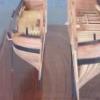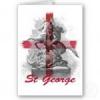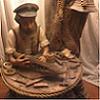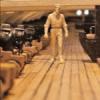Supplies of the Ship Modeler's Handbook are running out. Get your copy NOW before they are gone! Click on photo to order.
×

dcicero
-
Posts
266 -
Joined
-
Last visited
Reputation Activity
-
 dcicero got a reaction from dgbot in 18th Century Longboat by dcicero - FINISHED - Model Shipways - 1:48 - Tri-Club
dcicero got a reaction from dgbot in 18th Century Longboat by dcicero - FINISHED - Model Shipways - 1:48 - Tri-Club
From the Two Steps Forward, One Step Back school of ship modeling, here's another update!
Just getting the plank wet and clamping it to my glass plate, I edge-bent the broad strake.
I left it sit overnight to dry and here's the result.
Then I started sanding and carving. I found that the end of the strake fit a lot better into the keel rabbet. And I did two bends: the edge bend in the photos above and a bend around the curve of the hull. That bend was pretty subtle, but it made a big difference in how the plank fit. I'll add, too, that some of the edge bend went out of the plank when I wet it again to form the bend around the bow. Don't know how to minimize that.
So here's the broad strake fitted to the rabbet and the garboard strake.
When gluing the strake in place, I concentrated on the bow. I held it in place while the glue set, avoiding the use of clamps altogether. When it was almost dry, I put some clamps in place on the frames to just hold it in place. That avoided marring the surface of the plank with a clamp.
On my last attempt, there was a low spot between two of the frames. I know now why. The forward end of the garboard strake is a little low. Fitting the broads strake so that it lined up perfectly made that strake a little low too and formed the low spot. I let the broad strake lie where it's supposed to be this time, so there's a very, very slight difference in height at that point between those two strakes, but that will sand out, I'm confident. Had I done what I did last time, that dent would have needed filling.
I only applied glue to the first six or so frames and the edge of the plank that far back. The bend around the stern still needs to be done. I think I'll be in good shape just wetting the after end of the plank, bending it around the stern and clamping it in place.
I've made a lot of sawdust out of basswood planks... I think I'm going to have to order another bundle of them from ModelExpo because I doubt I'm going to be able to finish the planking with what came in the kit. There was plenty there to allow for mistakes, but not quite enough to allow for my mistakes!
Dan
-
 dcicero got a reaction from Ryland Craze in 18th Century Longboat by dcicero - FINISHED - Model Shipways - 1:48 - Tri-Club
dcicero got a reaction from Ryland Craze in 18th Century Longboat by dcicero - FINISHED - Model Shipways - 1:48 - Tri-Club
From the Two Steps Forward, One Step Back school of ship modeling, here's another update!
Just getting the plank wet and clamping it to my glass plate, I edge-bent the broad strake.
I left it sit overnight to dry and here's the result.
Then I started sanding and carving. I found that the end of the strake fit a lot better into the keel rabbet. And I did two bends: the edge bend in the photos above and a bend around the curve of the hull. That bend was pretty subtle, but it made a big difference in how the plank fit. I'll add, too, that some of the edge bend went out of the plank when I wet it again to form the bend around the bow. Don't know how to minimize that.
So here's the broad strake fitted to the rabbet and the garboard strake.
When gluing the strake in place, I concentrated on the bow. I held it in place while the glue set, avoiding the use of clamps altogether. When it was almost dry, I put some clamps in place on the frames to just hold it in place. That avoided marring the surface of the plank with a clamp.
On my last attempt, there was a low spot between two of the frames. I know now why. The forward end of the garboard strake is a little low. Fitting the broads strake so that it lined up perfectly made that strake a little low too and formed the low spot. I let the broad strake lie where it's supposed to be this time, so there's a very, very slight difference in height at that point between those two strakes, but that will sand out, I'm confident. Had I done what I did last time, that dent would have needed filling.
I only applied glue to the first six or so frames and the edge of the plank that far back. The bend around the stern still needs to be done. I think I'll be in good shape just wetting the after end of the plank, bending it around the stern and clamping it in place.
I've made a lot of sawdust out of basswood planks... I think I'm going to have to order another bundle of them from ModelExpo because I doubt I'm going to be able to finish the planking with what came in the kit. There was plenty there to allow for mistakes, but not quite enough to allow for my mistakes!
Dan
-
 dcicero got a reaction from fatih79 in 18th Century Longboat by dcicero - FINISHED - Model Shipways - 1:48 - Tri-Club
dcicero got a reaction from fatih79 in 18th Century Longboat by dcicero - FINISHED - Model Shipways - 1:48 - Tri-Club
Time for another update...
Toni and Bob had a look at my Long Boat at Saturday's meeting of The Nautical Research and Model Ship Society of Chicago and provided some great guidance. Here's the thing. The last two strakes are distorted at the bow, as you can see here.
If I were to continue planking, that distortion would just get worse and the end product wouldn't be to my liking. Just my personality, but that's the kind of thing that would bother me to my grave, so I made the decision to do some deconstruction. That started on Sunday.
Because I'd secured the planks with white glue -- good call in retrospect -- wetting the joints softened the glue and allowed me to remove them without too much trouble. To be sure, there was some clean-up needed, but, in the end, everything worked out fine.
Looking at Toni and Bob's garboard strake, they look a lot like mine. (Toni recommended I cut the garboard back some more. I'm thinking I can just thin it a little bit to reduce the amount the next planks need to curve.)
Now it's time to give it another try. Here are a few things I'm going to do differently:
Just wet the planks rather than cook them. I know heating them in the microwave makes them as pliable as noodles, but the consensus was that it's overkill for what I'm trying to achieve. Take the edge bending slowly. After one bend, mine would snap back into shape. Bob tells me it can take a couple of attempts before the plank keeps the desired shape. Carve the plank to fit. I was under the impression that I could just bend the planks into shape. Now I know I have to do both: bend and carve to get the plank into the proper form. Just hold the plank in place while adhering it to the frames. I was using too much clamp pressure and deforming the planks. I think this will help avoid the problems I had before with putting big divots in the planks.
Let's see how this works!
-
 dcicero got a reaction from nehemiah in Rigging Ratlines
dcicero got a reaction from nehemiah in Rigging Ratlines
Last night, I started tying knots. I found this picture somewhere on Model Ship World. (I'm sorry, but I forget where...) And I liked the looks of these knots.
Two things became clear pretty fast. First, it was hard to tighten the cow hitch. I'd put some tension on it and it'd look good, but as soon as I let go, it loosened up. Second, I'm not sure how to tie those clove hitches. Mastini recommends simple overhand knots in his Ship Modeling Simplified book. Those are certainly simple, but they don't look as good as those clove hitches. Not sure which way to go on those two issues.
Also, Mastini recommends using tan thread for the ratlines and that's what's shown in this picture, but most of the models I've seen use the same color for the ratlines as for the shrouds. I think I'm going to go with the darker color, but I'd be interested in the opinions of others.
Finally, getting the right tension on the ratlines between the shrouds seems to be a challenge. Anyone got a good method for that? Or is this just a task that requires a lot of fiddling to get right?
Dan
-
 dcicero got a reaction from st george in 18th Century Longboat by dcicero - FINISHED - Model Shipways - 1:48 - Tri-Club
dcicero got a reaction from st george in 18th Century Longboat by dcicero - FINISHED - Model Shipways - 1:48 - Tri-Club
And here's the corrected table.
I think it's interesting how consistent the widths are from Frame A aft.
You can see my progress on the two garboard strakes here. The starboard one took me two building sessions to complete. The port one? I worked on it while the kids were running around. Took maybe an hour, total. Seems like that happens a lot. The first time you work through a problem like this, it takes forever and the results are just okay. The second time, it goes a lot faster and the results are better. The moral of the story? Like the Nike ads used to say: Just Do It.
Dan
-
 dcicero got a reaction from Ferit in Rigging Ratlines
dcicero got a reaction from Ferit in Rigging Ratlines
Last night, I started tying knots. I found this picture somewhere on Model Ship World. (I'm sorry, but I forget where...) And I liked the looks of these knots.
Two things became clear pretty fast. First, it was hard to tighten the cow hitch. I'd put some tension on it and it'd look good, but as soon as I let go, it loosened up. Second, I'm not sure how to tie those clove hitches. Mastini recommends simple overhand knots in his Ship Modeling Simplified book. Those are certainly simple, but they don't look as good as those clove hitches. Not sure which way to go on those two issues.
Also, Mastini recommends using tan thread for the ratlines and that's what's shown in this picture, but most of the models I've seen use the same color for the ratlines as for the shrouds. I think I'm going to go with the darker color, but I'd be interested in the opinions of others.
Finally, getting the right tension on the ratlines between the shrouds seems to be a challenge. Anyone got a good method for that? Or is this just a task that requires a lot of fiddling to get right?
Dan
-
 dcicero got a reaction from egkb in 18th Century Longboat by dcicero - FINISHED - Model Shipways - 1:48 - Tri-Club
dcicero got a reaction from egkb in 18th Century Longboat by dcicero - FINISHED - Model Shipways - 1:48 - Tri-Club
It's time I got around to working on my 18th Century Longboat. I'm about six months behind my fellow Tri-Club Members. (I'm a member of the Nautical Research & Model Ship Society of Chicago.) My excuse? I was finishing up Scottish Maid. This was my first model -- since I was a teenager, anyway -- and it took me eight years to finish.
Granted, my wife and I had two kids during that eight years and there were several years when nothing got done, but still -- start to finish -- eight years.
I think it turned out really well, though. I entered it in the 37th Annual Model Ships and Boats Contest and Display. On May 18th, it was awarded a Gold Award and I got received the Best Novice Builder Award. I'm still walking on air. It was the culmination of a lot of work. The ship was judged by people who really know what they're looking at and the contest was held in Manitowoc, Wisconsin. I grew up near there, in Green Bay. It was like being recognized by the people of my native land. (For those who don't know, life in Wisconsin, is very different from life in Illinois, where I live now. I live near Chicago, a city of 2.6 million, about 8 million in the metro area. Green Bay, when I was growing up, had a population of 47,000. There is no metro area ... unless cow pastures count.)
Anyway, while others in the Tri-Club were making progress on their longboats, I was toiling away on Scottish Maid.
-
 dcicero got a reaction from fatih79 in 18th Century Longboat by dcicero - FINISHED - Model Shipways - 1:48 - Tri-Club
dcicero got a reaction from fatih79 in 18th Century Longboat by dcicero - FINISHED - Model Shipways - 1:48 - Tri-Club
Thanks, Toni and Bob!
I decided to go the "strips across the top" method. Here's a picture of the model with the last two strips strapped down in place. I checked it this morning and everything is nice and stable. This'll make fairing the bulkheads less stressful.
Dan
-
 dcicero got a reaction from Mirabell61 in Rigging Ratlines
dcicero got a reaction from Mirabell61 in Rigging Ratlines
Last night, I started tying knots. I found this picture somewhere on Model Ship World. (I'm sorry, but I forget where...) And I liked the looks of these knots.
Two things became clear pretty fast. First, it was hard to tighten the cow hitch. I'd put some tension on it and it'd look good, but as soon as I let go, it loosened up. Second, I'm not sure how to tie those clove hitches. Mastini recommends simple overhand knots in his Ship Modeling Simplified book. Those are certainly simple, but they don't look as good as those clove hitches. Not sure which way to go on those two issues.
Also, Mastini recommends using tan thread for the ratlines and that's what's shown in this picture, but most of the models I've seen use the same color for the ratlines as for the shrouds. I think I'm going to go with the darker color, but I'd be interested in the opinions of others.
Finally, getting the right tension on the ratlines between the shrouds seems to be a challenge. Anyone got a good method for that? Or is this just a task that requires a lot of fiddling to get right?
Dan
-
 dcicero reacted to Maury S in 18th Century Longboat by Maury - FINISHED - Model Shipways
dcicero reacted to Maury S in 18th Century Longboat by Maury - FINISHED - Model Shipways
Aligning the ends of the strakes at the bow has been a problem for me so I now just push a pin through the deepest part of the rabbet at the top of one side to align the top of the opposite side strake. Remove the pin and you have a nice clean dot. It works for me better than measuring.
Maury
-
 dcicero got a reaction from dgbot in 18th Century Longboat by dcicero - FINISHED - Model Shipways - 1:48 - Tri-Club
dcicero got a reaction from dgbot in 18th Century Longboat by dcicero - FINISHED - Model Shipways - 1:48 - Tri-Club
It's time I got around to working on my 18th Century Longboat. I'm about six months behind my fellow Tri-Club Members. (I'm a member of the Nautical Research & Model Ship Society of Chicago.) My excuse? I was finishing up Scottish Maid. This was my first model -- since I was a teenager, anyway -- and it took me eight years to finish.
Granted, my wife and I had two kids during that eight years and there were several years when nothing got done, but still -- start to finish -- eight years.
I think it turned out really well, though. I entered it in the 37th Annual Model Ships and Boats Contest and Display. On May 18th, it was awarded a Gold Award and I got received the Best Novice Builder Award. I'm still walking on air. It was the culmination of a lot of work. The ship was judged by people who really know what they're looking at and the contest was held in Manitowoc, Wisconsin. I grew up near there, in Green Bay. It was like being recognized by the people of my native land. (For those who don't know, life in Wisconsin, is very different from life in Illinois, where I live now. I live near Chicago, a city of 2.6 million, about 8 million in the metro area. Green Bay, when I was growing up, had a population of 47,000. There is no metro area ... unless cow pastures count.)
Anyway, while others in the Tri-Club were making progress on their longboats, I was toiling away on Scottish Maid.
-
 dcicero got a reaction from aykutansin in 18th Century Longboat by dcicero - FINISHED - Model Shipways - 1:48 - Tri-Club
dcicero got a reaction from aykutansin in 18th Century Longboat by dcicero - FINISHED - Model Shipways - 1:48 - Tri-Club
Fitting the false keel required some sand-fit-sand-fit too. I really made an effort to get the two pieces to fit together without forcing them. I figured the last thing that little joint needed was a torque that was going to force it apart. In the end, it worked out really well and was glued together using the glass plate again.
-
 dcicero got a reaction from WackoWolf in Mast alignment
dcicero got a reaction from WackoWolf in Mast alignment
I've been warned so many times not to glue the masts in that I'd be scared to do so!
For alignment, I use the little jib described in Mastini's Ship Modeling Simplified. It's just two small dowels of equal length, placed parallel to each other and pinned together at one end. It's a little bipod. With the two ends placed against the bulkheads, the pin should be right in the middle of the mast. It's really easy to check alignment as you work. On my Scottish Maid, the foremast alignment was a little tricky. I used the shrouds to hold it properly in place and checked as I progressed with the "mast alignment tool." Worked out just fine.
Dan
-
 dcicero got a reaction from BareHook in Mast alignment
dcicero got a reaction from BareHook in Mast alignment
I've been warned so many times not to glue the masts in that I'd be scared to do so!
For alignment, I use the little jib described in Mastini's Ship Modeling Simplified. It's just two small dowels of equal length, placed parallel to each other and pinned together at one end. It's a little bipod. With the two ends placed against the bulkheads, the pin should be right in the middle of the mast. It's really easy to check alignment as you work. On my Scottish Maid, the foremast alignment was a little tricky. I used the shrouds to hold it properly in place and checked as I progressed with the "mast alignment tool." Worked out just fine.
Dan
-
 dcicero got a reaction from isali in Rigging Ratlines
dcicero got a reaction from isali in Rigging Ratlines
Last night, I started tying knots. I found this picture somewhere on Model Ship World. (I'm sorry, but I forget where...) And I liked the looks of these knots.
Two things became clear pretty fast. First, it was hard to tighten the cow hitch. I'd put some tension on it and it'd look good, but as soon as I let go, it loosened up. Second, I'm not sure how to tie those clove hitches. Mastini recommends simple overhand knots in his Ship Modeling Simplified book. Those are certainly simple, but they don't look as good as those clove hitches. Not sure which way to go on those two issues.
Also, Mastini recommends using tan thread for the ratlines and that's what's shown in this picture, but most of the models I've seen use the same color for the ratlines as for the shrouds. I think I'm going to go with the darker color, but I'd be interested in the opinions of others.
Finally, getting the right tension on the ratlines between the shrouds seems to be a challenge. Anyone got a good method for that? Or is this just a task that requires a lot of fiddling to get right?
Dan
-
 dcicero got a reaction from nehemiah in Rigging Ratlines
dcicero got a reaction from nehemiah in Rigging Ratlines
Based on the recommendations from you gentlemen, I started on the ratlines. Scottish Maid is in 1:50 scale, so the spacing between the ratlines should be 0.32 inches. Luckily, I have a ruler graduated in 10ths and 100ths of inches, so ruling those lines on a piece of cardstock was simple.
Then I cut templates about 1.5 inches wide, whcih will fit nicely behind the shrouds.
You can see the final result.
-
 dcicero got a reaction from dafi in Rigging Ratlines
dcicero got a reaction from dafi in Rigging Ratlines
Thanks for the tip on wetting the ratline thread. I think I'm going to have to do that, based on my work last night...
First, I learned how to tie the two knots invoved in rigging the ratlines: the cow hitch and the clove hitch. I found a good video explanation of the clove hitch and as you can see in the photo below, those knots look pretty good. (Here's a link: http://www.ehow.com/video_2355229_tie-clove-hitch-knot.html)
As for the cow hitch, that one was pretty easy to figure out, but hard to get to lie correctly. You can see that in the photo too. Maybe wetting the line will help that out. I'll try that tonight if I can fit it in.
I tied four knots last night. Took me about 30 minutes. I'm going to have to get faster at that if I'm ever going to finish this job. That said, most of my time was spent figuring out how to do it. Repetition is going to speed this up a lot. I'm also going to take the suggestion of putting the vertical lines on my template. I can see how it would be easy to pull the ratlines together and distort the shrouds without some kind of guide.
Dan
-
 dcicero got a reaction from maso in Rigging Ratlines
dcicero got a reaction from maso in Rigging Ratlines
Thanks again to everyone for all the help. I've learned a few things, as the photo below illustrates.
Get the thread a little wet before using it. That'll get the kinks out of it and make it a lot easier to work with. Use a template to get the vertical spacing right. Use a template to ensure the shrouds aren't being pulled together. Do every fourth ratline and then go back and do the rest. Things tend to go a little faster with a little experience.
Although it probably won't make much difference to people looking at the model, I really do like the idea of not having loose ends hanging off the sides of the ratlines. I was determined to get the cow hitch - clove hitch - clove hitch - cow hitch series right. I've found that it's not that tough once you get the hang of it.
Box 1 shows my first attempts: loose knots and ... what's that? A string ball? Box 2 shows subsequent attempts: properly tied and tighter. (These were done after I learned I should get the thread a little damp to take the kinks out of it and make it easier to work with. Box 3 shows what I consider to be properly done ratlines. The knots are tight, the they're not pulling the shrouds together and the knots are properly tied.
If I can just replicate Box 3 about a thousand times, I'll be good to go! Honestly, this is about the most mindless part of my entire building experience. It's pretty relaxing. Once you get the hang of the two knots, it goes pretty quickly.
I'm a little anxious about rigging the foremast ratlines. Scottish Maid is a clipper schooner, so I have the foremast yards right in the way, along with all the other rigging. I'm hoping my experience with the main mast will serve me well on the trickier foremast.
Next time, I'm going to do all the ratlines when I step the mast and rig the shrouds...
Dan
-
 dcicero reacted to Ulises Victoria in Making rope coils
dcicero reacted to Ulises Victoria in Making rope coils
I use this jig to make my pin coils. Just some nails in an angled piece of wood. When the coils are made, I spray them with hair spray and let dry. The plastic push pins allow for easy removal. Has worked very good for me.
-
 dcicero got a reaction from aviaamator in Rigging Ratlines
dcicero got a reaction from aviaamator in Rigging Ratlines
Based on the recommendations from you gentlemen, I started on the ratlines. Scottish Maid is in 1:50 scale, so the spacing between the ratlines should be 0.32 inches. Luckily, I have a ruler graduated in 10ths and 100ths of inches, so ruling those lines on a piece of cardstock was simple.
Then I cut templates about 1.5 inches wide, whcih will fit nicely behind the shrouds.
You can see the final result.
-
 dcicero got a reaction from Ryland Craze in How to Taper Masts?
dcicero got a reaction from Ryland Craze in How to Taper Masts?
I did a presentation on masts and spars for the club I belong to. (Shameless plug for the The Nautical Research and Model Ship Society of Chicago.) I've attached the presentation. I use a small lathe made by Harbor Freight Tools, a digital caliper and a file.
Hope this helps!
Dan
Masts and Spars.pdf












